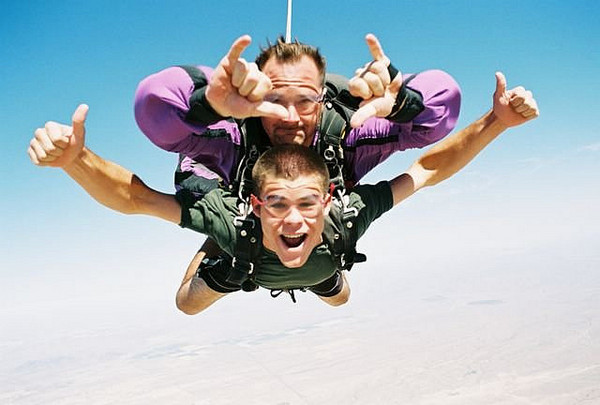Tandem skydiving allows first-time jumpers to experience the rush of free falling without the time it takes to invest in a solo jump. Tandem skydiving is where a student is joined with a harness to a coupled teacher during the jump. In practice, this setup is the best way to teach and learn skydiving; the coach can instruct the student during the entire skydiving process while the proximity of the teacher and the fastness of the harness allow the student to feel more secure. The teacher directs the student through the entire jump from the exit of the plane, through freefall, controlling the canopy, and landing. For tandem skydiving, the student typically need only to receive the very basic instruction. Here are seven things to expect during a tandem skydive.

- Tandem SkydiveGonzo fan2007 / Foter.com / CC BY
The Centers
Skydiving centers in the U.S. are abundant, as over 400 skydiving locations from small to large exist mostly on smaller airports. Many centers are opened year around, while, in particular some centers in the northern states stay closed during the winter period. A popular way of contacting most skydiving centers in the U.S. is by calling the toll free number 1-800-SKY-DIVE, which automatically connects a call to a center in the caller’s area.
The Equipment
Before a student undergoes a tandem skydive, a student will notice how the skydiving equipment may differ from a traditional skydive. In particular, a drogue parachute is employed, in contrast to a typical skydive which will not need this specific parachute. This parachute may be used just after leaving the aircraft so that a decrease in velocity may be attained. In addition, the principle parachute will be much larger as it will need to support two people rather than one. And finally, a third parachute has been arranged by the FAA to automatically deploy in case a jumper has dropped below a certain altitude in free fall.
The Training
The coach will proceed to instruct a student on how to exit the aircraft, as well as develop the proper skydiving body form. The teacher controls the jump from the exit of the plane, to freefall, to landing, and therefore, training for a tandem jump is basic. The student is attached to the teacher via a harness system.
The Jump
The first jump will be more of a roll than an actual jump. Both the teacher and student will be harnessed together on the floor of aircraft with the student’s arms across their chest. When it’s time to exit the plane the teacher will roll, taking the student with them into the air where they will both assume the appropriate diving positions.
The Freefall
The freefall will last about 40 seconds to a minute depending on altitude. Then the teacher deploys the parachute at approximately 4,000 feet above the ground and guides the student to a safe landing. In contrast to what most people expect, freefall does not feel like a roller coaster drop. The freefall is actually the opposite feeling of being supported while floating with the sensation of wind against the body. One way to test a freefall before committing to a skydive would be to experience a skydiving simulator, which is essentially a vertical wind tunnel.
The Landing
After five to seven minutes under the parachute, the teacher and student will touchdown in a safe and comfortable manner. Today’s square parachutes allow for a parachute landing that can not be any simpler or safer. A parachute used on a tandem jump is much larger than a typical parachute, and therefore more docile than even an experienced jumper’s would be. Thus, the landings that are achieved are as soft as stepping down a stair step.
The Next Jump
A student will continue to train under the direct supervision of a teacher for as many jumps as the program requires. Typically a portion of the training takes place on the ground, which is followed by a jump. After roughly 12 to 13 jumps, a student is often found passable, and is thus cleared to jump without supervision. Since most students prefer to make two or three jumps a week, it takes a student a month to graduate.
Tandem skydiving is the safest jump for first-time jumpers. In fact, almost 70% of the jumps made by first-time jumpers in the U.S. are tandem jumps. With this option many get to decide if they like the very basic essence of skydiving altogether, without the time it takes to train over several days or weeks. If a jumper decides that they would like to pursue jumping solo then an AFF program would suit them.


